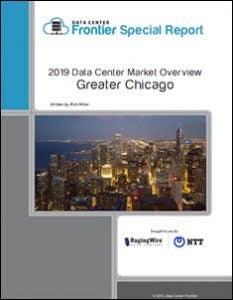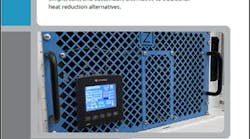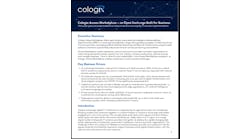We continue our series of stories on the leading geographic markets for data center space with a report on the Greater Chicago data center market. Data Center Frontier is partnering with datacenterHawk to provide in-depth market reports on each city we profile. In this post, we explore what drives supply and demand trends for the data center industry in the downtown Chicago market.
Download the full report.
Trends in Demand
Companies searching for data centers in the Chicago market include those in the financial, technology, telecom, insurance, and healthcare industries. Like any big American city, downtown Chicago has limited space priced at a premium. In general, users locate their data centers in downtown Chicago in spite of high costs, because they require low-latency connectivity. Data center providers understand this need and have built accordingly, tapping the fiber-ring infrastructure serving Chicago’s Board of Trade, Mercantile Exchange, and all of the major financial enterprises with offices downtown.
Demand in the Downtown Chicago market will continue to be driven by connectivity, inter-connection and access to the city’s financial exchanges and business customers in the central business district.
The marquee facility in Downtown Chicago is 350 East Cermak, a massive 1.1 million SF carrier hotel operated by Digital Realty. Data centers inside 350 East Cermak often market themselves as operating inside one of the world’s largest carrier hotels.
The Chicago market has a healthy balance of data center requirements coming from both outside and inside the market. Colocation users find the Chicago market attractive because of its central location and proximity to large, corporate businesses.
The Chicago market is attractive to data center users for several reasons:
- Favorable Business Climate — Chicago is home to numerous Fortune 500 companies, with almost 40 headquartered in the metro area. The unemployment rate in the Chicago metropolitan area has declined in recent years, falling from 12.2% in 2009 to the current 3.8, according to the Bureau of Labor Statistics. According to JLL, Chicago is the second largest office market in the U.S., with nearly 250 million square feet of office space.
- Competitive Colocation/Cloud Environment — The Chicago market benefits from investments by data center developers large and small along with a central location, an abundance of fiber and several Internet peering exchanges.
- Relatively Low Power Cost — Chicago’s electricity costs are lower than the national average and competitive with other large markets.
- Low Risk of Natural Disasters — Compared to hurricane and earthquake-prone coastal cities, catastrophic natural disasters are almost unheard of in Chicago.
DatacenterHawk reports that there were 5.9 MW of absorption in the Greater Chicago data center market in the second quarter of 2019, roughly consistent with trends over the past year, in which absorption has fluctuated between 3 MWs and 6.5 MWs per quarter.
The growth of cloud computing has had significant benefits for the Chicago market. Some hyperscale providers have built large campuses in rural areas. But latency and proximity to customers remain important priorities for online service platforms, making Chicago attractive for its geography and critical mass of customers.
Chicago has an average of 300 days out of the year that are cool enough to pipe outside air into a data center. This “free cooling” helps to lower the total energy costs associated with operating a data center.
Google was the most active tenant in the Chicago market in 2018, leasing 4.4 MWs of space in deals with QTS and Equinix, according to a report from North American Data Centers. Rackspace, Microsoft and Oracle have also built significant cloud operations in Chicago-area data centers.
Chicago’s active community of cloud providers also provides a “future-proofing” effect, increasing the likelihood that demand for space will remain strong even as corporate IT users shift workloads from on-premises data centers to cloud platforms. Some of these requirements will move to “hyperscale” clouds, while others may shift to service providers offering services targeting specific industry verticals or use cases.
Climate is a factor in Chicago’s appeal to data center providers and customers with significant requirements. Chicago has an average of 300 days out of the year that are cool enough to pipe outside air into a data center. This “free cooling” helps to lower the total energy costs associated with operating a data center.
Some customers choose to use space in both Chicago-area markets, using space downtown for applications that require low latency or interconnections, while using larger footprints in the Suburban Chicago market for data storage and bulk processing.
The largest 2018 deal in Suburban Chicago was a 3.3 MW deal for Nokia with Digital Realty, according to North American Data Centers, highlighting the sub-market’s appeal for enterprise customers.
In 2018 and 2019 most of the wholesale deals in Chicago have been in the 500kW to 3 MW range. During that period, we have not seen any of the massive hyperscale deals from previous years, which included a 14.5 MW lease in 2017 and a 30 MW lease in 2016.
There are signs that Illinois’ passage of tax incentives is generating new interest in the Greater Chicago market. Providers in the region report an increase in inquiries about space, a trend borne out in recent spikes in search traffic on datacenterHawk.
Trends in Supply
Chicago is the sixth-largest data center market in commissioned data center capacity, following Northern Virginia, Northern California, Dallas/Fort Worth, Phoenix and Northern New Jersey.
Chicago continues to be one of the most active markets for new development, with more than 200 MWs of capacity either under construction or in the planning phases.
Historically, downtown inventory consists of space in large, multi-tenant office buildings converted for data center use. Existing space can be particularly “sticky” with limited turnover due to the value of a downtown presence in key verticals. The availability of large footprints is improving with the construction of new inventory from QTS and now CoreSite.
With a 13.8% regional vacancy rate for data centers, there is existing supply in both the downtown and suburban Chicago markets. Both sub-markets will be adding new inventory in coming months, as CoreSite is building a new facility downtown, while RagingWire, Iron Mountain, and STACK Infrastructure have data centers under construction in Suburban Chicago.
In recent years, the Suburban Chicago market has seen active development in the area surrounding O’Hare Airport, especially Elk Grove Village and Franklin Park. A brief period of limited power supply was addressed with the 2018 completion of a new ComEd substation in Itasca, which will also support additional capacity in Elk Grove Village. Long-range capacity plans for the area call for construction of another new ComEd substation in north Elk Grove Village in the future.
The next entry in this series on the Chicago colocation market will give a full rundown of highlights of development activity in the Greater Chicago market for 2019.
If you missed the first entry in the series, go here to catch up.
For full details on the Chicago data center market, we invite you to download the “Greater Chicago 2019 Data Center Market Overview,” sponsored by RagingWire Data Centers.







